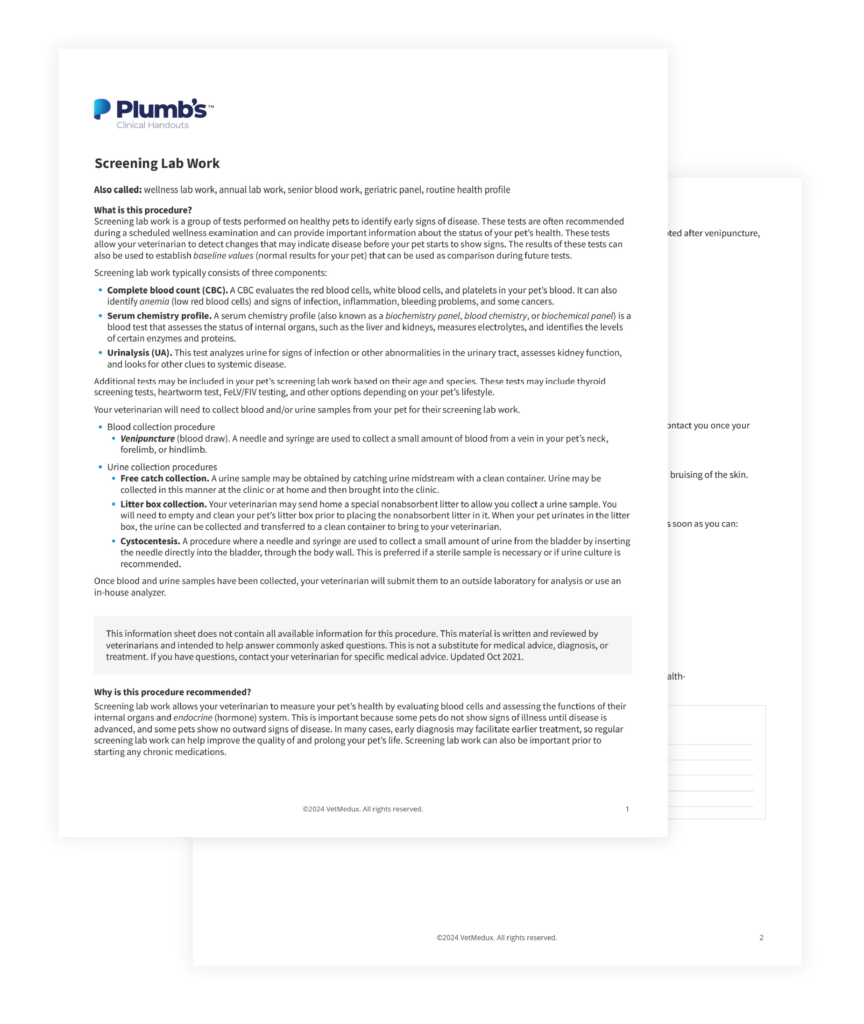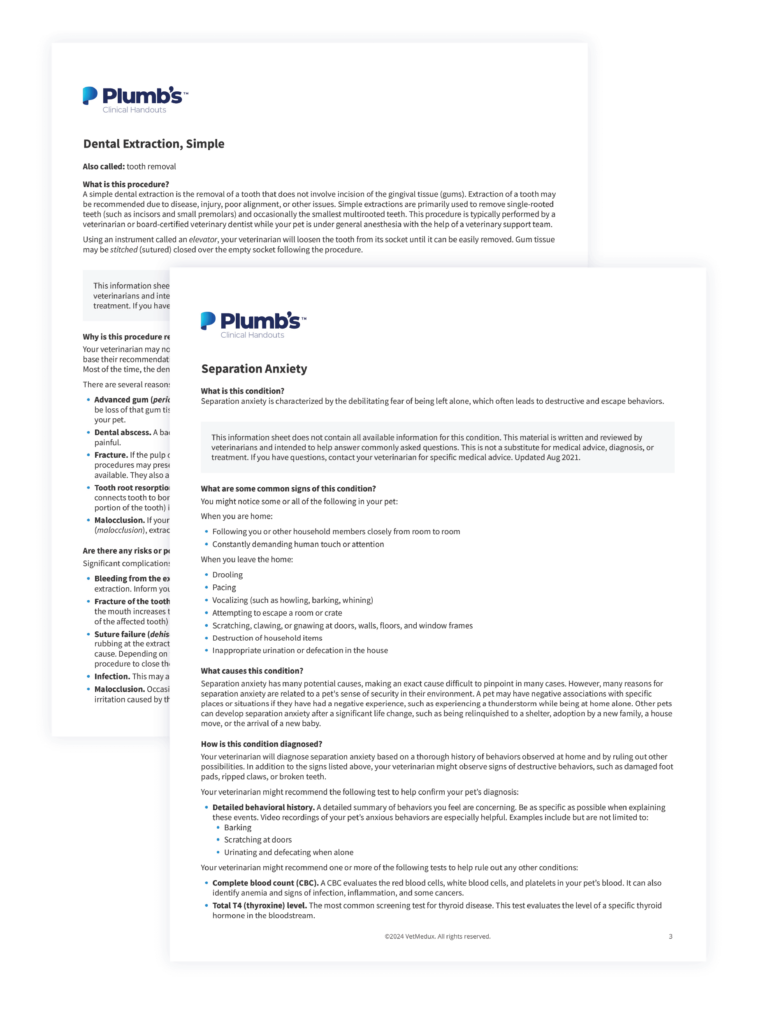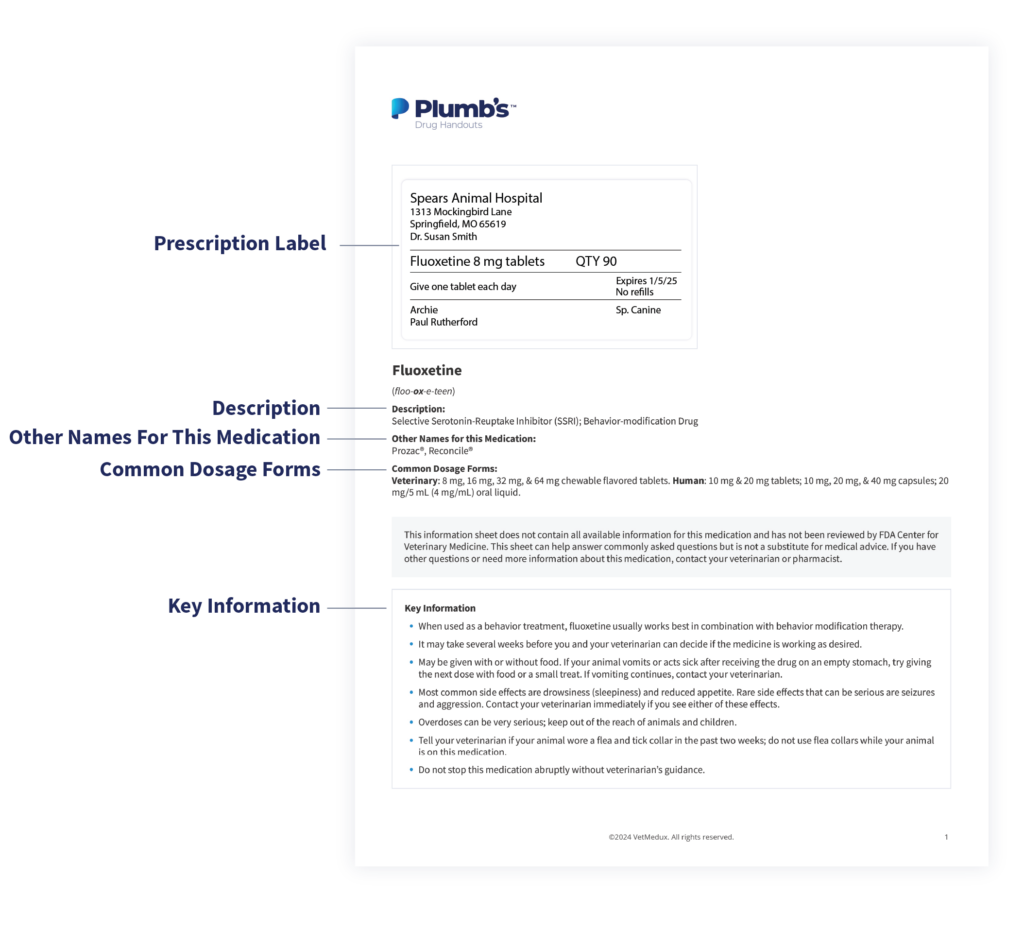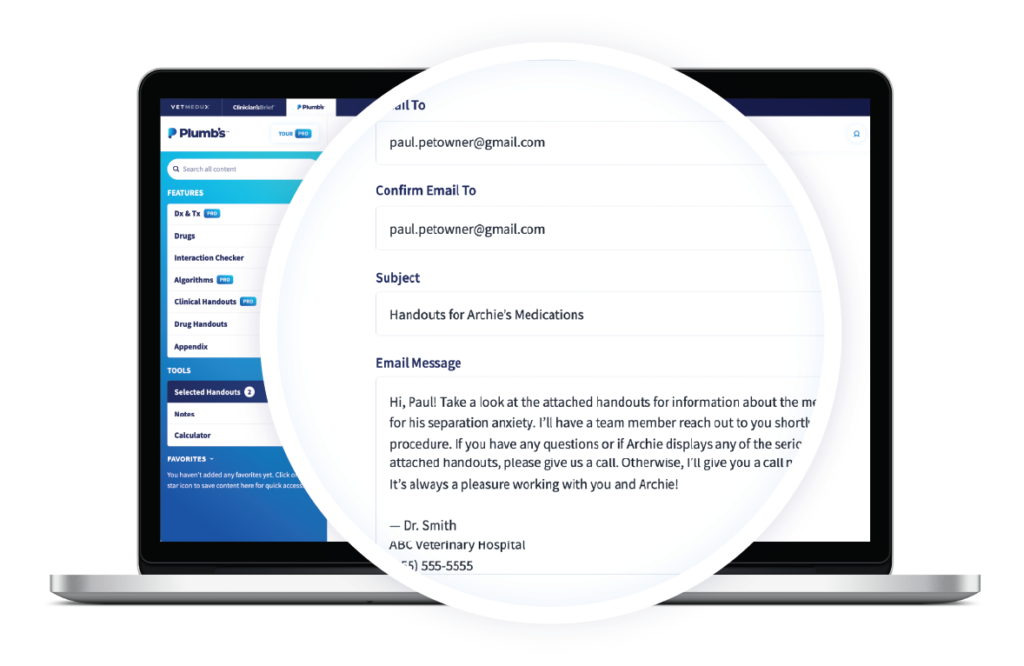Have you ever found yourself in the midst of carefully explaining a complex topic—like atopic dermatitis or hyperadrenocorticism—to a pet owner only to notice their eyes starting to glaze over? They start fidgeting and looking around the exam room, and you know you’re losing their attention. It’s a scenario every veterinarian is all too familiar with. No matter how good our communication skills are, pet owners can quickly become overwhelmed by the intricacies of a new diagnosis or treatment plan, hindering their ability to absorb vital information. We all know how crucial effective veterinary client education is to the health of our patients—so how can we make care clear without overwhelming the pet owner?
There’s a simple step we can take: provide handouts. Just as in human medicine, where written handouts have proven benefits, the same holds for veterinary practice. Research in human medicine shows that providing written resources after appointments can decrease recovery time, improve satisfaction with services provided, decrease stress and anxiety, reduce hospital readmissions, improve compliance, and generally improve the confidence of patients to manage care and seek appropriate follow-up care.1
In this blog post, we’ll delve into the importance of written handouts in veterinary care, exploring how they can empower pet owners to understand their pet’s condition and feel confident about providing care at home. Let’s look at a case that demonstrates the impact of client handouts on preventing information overload and fostering informed decision-making.
Meet Your Patient and Pet Owner
Archie, a 2-year-old neutered male American cocker spaniel, presents for his annual wellness exam. Overall, he’s been doing well at home, but his owner, Paul, has recently returned to work outside of the house, and he has discovered that Archie suffers from separation anxiety.
Archie will whine and bark constantly while Paul is at work, and he chews and destroys household items. When he leaves, Paul now puts Archie in a crate, but Archie chews on the bars and destroys the crate bedding.
You perform a physical exam and find a complicated crown fracture of his maxillary third incisor, likely secondary to Archie chewing on his crate bars. Otherwise, his physical exam is unremarkable.
You begin explaining the multimodal nature of treating separation anxiety and what’s involved in counterconditioning and desensitization. You’re doing everything you can to avoid overwhelming your client with information, but you can sense that Paul is struggling to take in all the details, and you haven’t even touched on the need for a dental procedure yet.
How Pet Owner Handouts Can Improve Veterinary Client Education
Veterinary client education is crucial in situations like Paul’s, where the patient’s outcome largely depends on whether the pet owner clearly understands and can adhere to your recommendations. You decide to use written veterinary client handouts to guide your communications and give Paul time to digest the information you’ve given him, so you turn to Plumb’s Pro™.
Clinical handouts in Plumb’s Pro™ cover essential information about clinical conditions, common procedures, laboratory findings, and preventive care topics, and drug handouts provide pet owners with everything they need to know about the drugs we prescribe.
You’d like to do some screening blood work before starting Archie on anti-anxiety medication, so you print off the handout on screening lab work that goes over what to expect and why it’s recommended. After you read through the handout with Paul, highlighting the key points, he agrees to the blood work.

You then print the handout on simple dental extractions, which discusses what the procedure entails, why it’s recommended, the potential complications, and what’s involved in recovery. To make sure Paul understands the separation anxiety diagnosis and treatment options—and when to call you—you also print the handout on separation anxiety.

You let Paul know you’ll call him with blood work results and ask him to read through the handouts and digest all the information.
In a few days, you call Paul back to let him know Archie’s blood work results are normal and review your treatment plan. You elect to start treatment with fluoxetine at 1 mg/kg PO every 24 hours, along with alprazolam short-term until the fluoxetine takes effect (0.05 mg/kg 30 minutes before the owner leaves home).
To ensure Paul understands all the details about the drugs you’re prescribing, you turn back to Plumb’s™ for drug handouts.
Easily Share Trusted Drug Information With Pet Owners
Providing clear, easy-to-understand information about pet medications is a crucial part of effective veterinary client education. Each of the 550+ drug handouts in Plumb’s™ clearly explains everything a pet owner needs to know about the drugs you prescribe, like side effects, duration of therapy, and what to do if they miss a dose or have pills left over.
Providing drug handouts can support better adherence and keep your patients safer. But in some cases, they go beyond that to help you meet a legal requirement.
Laws like Lizzie’s Law (passed in California in 2018) and Buoy’s Law (expected to go into effect in New York in June 2024) require that every time a veterinarian prescribes, dispenses, or provides a drug to an animal, they must provide the pet owner with:
- The name and description of the drug
- Directions for use
- Actions to be taken in the event of a missed dose
- Instructions for proper storage
- Any common reasonably anticipated adverse effects
- Manufacturer precautions and relevant warnings
Finding the time to provide all this information when we’re already busy can be daunting. But when you use the drug handouts in Plumb’s™—in combination with your prescription label—you can quickly and efficiently fulfill the legal requirements.

You find the drug handouts for fluoxetine and alprazolam and email them to Paul directly from Plumb’s™. There’s a spot to add a personalized message before you send the email, so you let him know you’ll have a veterinary team member contact him to schedule Archie’s dental procedure.

When you use Plumb’s™ for veterinary client education, you can feel confident that you’re doing all you can to avoid overwhelming pet owners while helping them get all the information they need.
Already subscribed to Plumb’s™? Browse clinical or drug handouts.
Think you could use Plumb’s™ handouts in your practice? Choose your plan today
References
- Johnson A, Sandford J, Tyndall J. Written and verbal information versus verbal information only for patients being discharged from acute hospital settings to home. Cochrane Database Syst Rev. 2003;2003(4):CD003716. doi:10.1002/14651858.CD003716


